A couple of weeks ago I went to the local shore and noticed hundreds, maybe thousands of birds on the beach, the walkways and the piers. None of them seemed to be eating. They were all facing the sun, most of them with their legs tucked under their bodies. I wondered, how do the birds survive? What do they eat. They didn't seem to be fishing, or pecking the ground looking for insects.
Yesterday I went to the same shore. The temperature was about 20 degrees warmer. It was 55°F when we left the house, and the sun was high in the sky. Bird behavior was quite different during this visit. Note the bird swooping down from the sky in the following image. Apparently, the bird has spotted below something that might make a good meal.
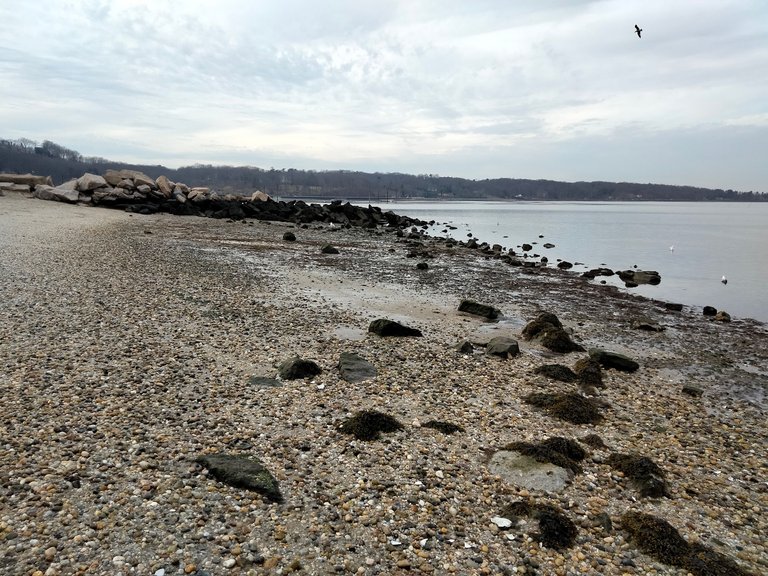
The gulls yesterday were obviously feeding, on shore and off. Pickings included not only fish, and shells, but apparently some kind of minute life that they pecked from the ground. Finally, as I was leaving I saw another source of food: trash. Humans had thrown a bag with leftover lunch. The birds had taken the bag out of the pail and had torn up the contents inside. Here is a very brief YouTube video (I shot it) that shows the birds hunting just off shore.
Here is a 2-part still sequence that shows how the gulls dive for fish (?). In the first photo the gull gets ready to dive. In the second photo the bird's head is under water as it snatches its prey.
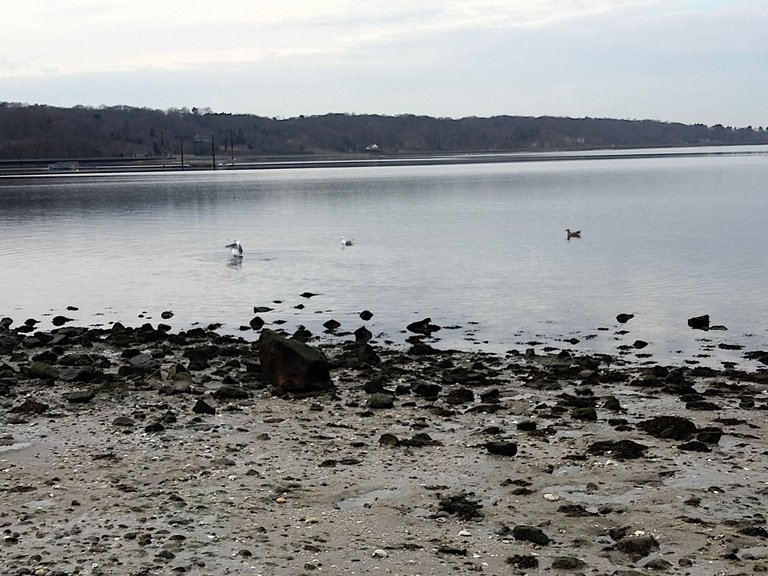
Snatching prey underwater:
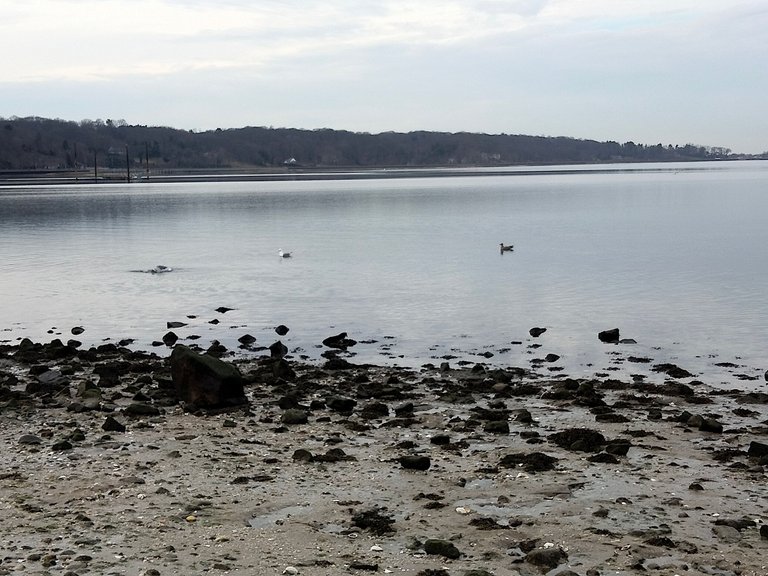
Here is another brief YouTube video I uploaded (from yesterday's visit) that shows the bird coming in for a dive landing.
Gulls are omnivores. When pressed, they prey not only on other animals, including other types of birds, but they even resort to cannibalism. They consume eggs and hatchlings. According to an article in Birdforum.net, "some gulls in the breeding season live almost entirely on the eggs and young of their own species. Usually males with no young of their own".
Yesterday I saw gulls fishing, clamming, and hunting for food on shore. Here is a picture of two gulls, one hunting in the water, one hunting on shore.

The birds may scavenge carrion, and also feast regularly on detritus left by humans. I caught a picture (and a brief video) of a group swarming over someone's discarded lunch bag. As I approached, the birds scattered and retreated to poles nearby.
Here's the shot of some birds feeding:
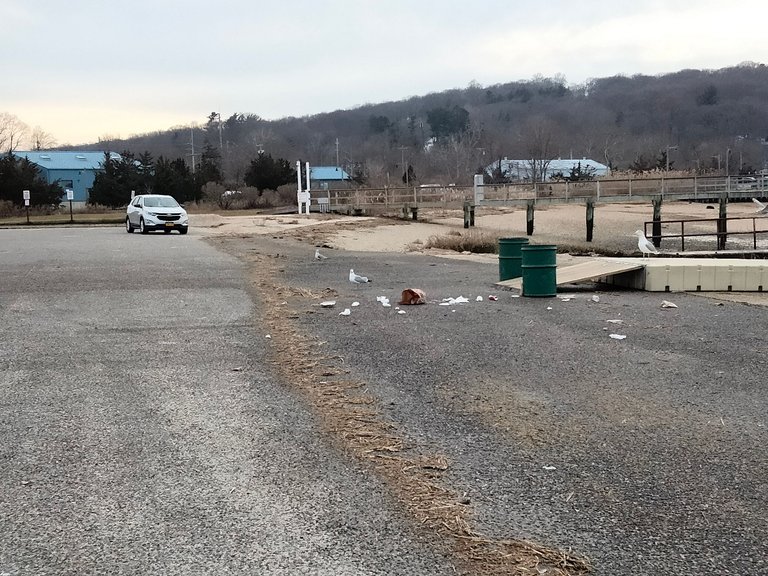
Here is my YouTube video of the birds feeding off the trash
After most of the birds flew off, I could see them all around, perched on poles, waiting to return. Here's a shot of them on the poles.
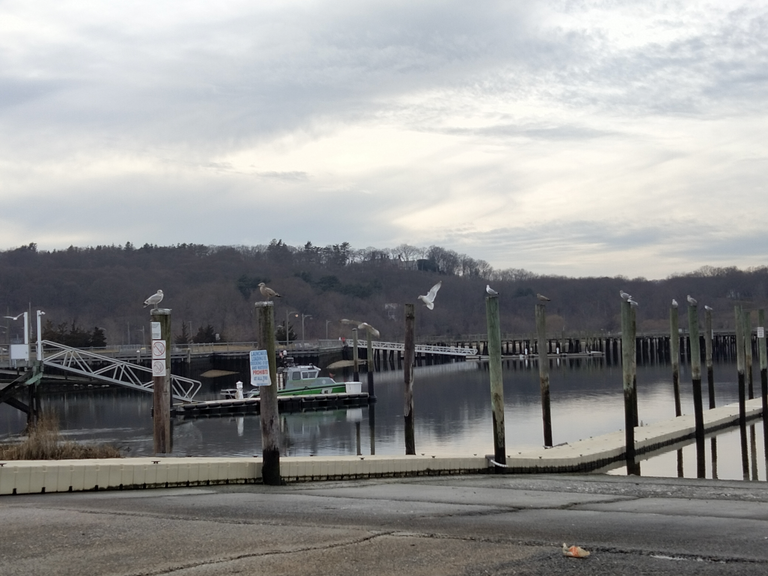
And more gulls, waiting farther off:
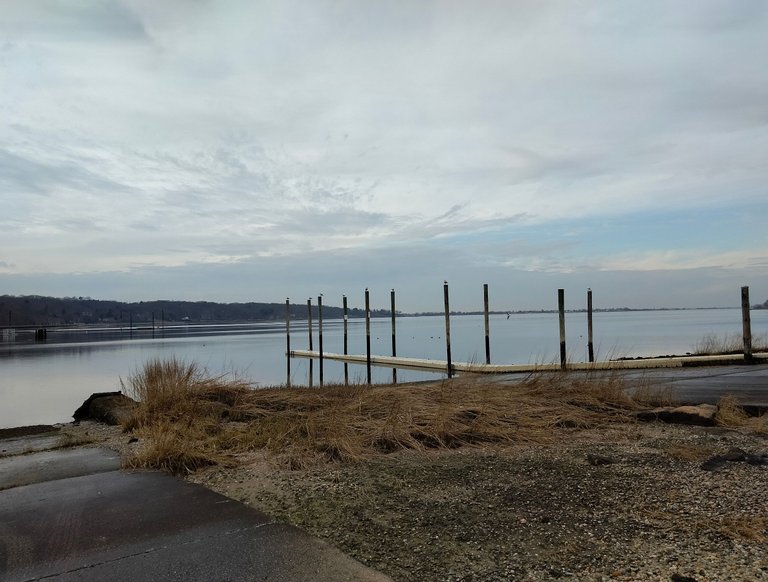
With the clamming, they would pick up a shell and drop it from a high height until the shell broke. They would then descend on the broken shell and feast. Sometimes (usually) this procedure became the occasion of a battle between gulls as several sought to poach the crushed crustacean.
Apart from the trash, the best feeding opportunity for the gulls seemed to be in and around the rocks. There I saw not only many birds, but quite a lot of activity. Here's a shot of the rocks and the birds hunting there.
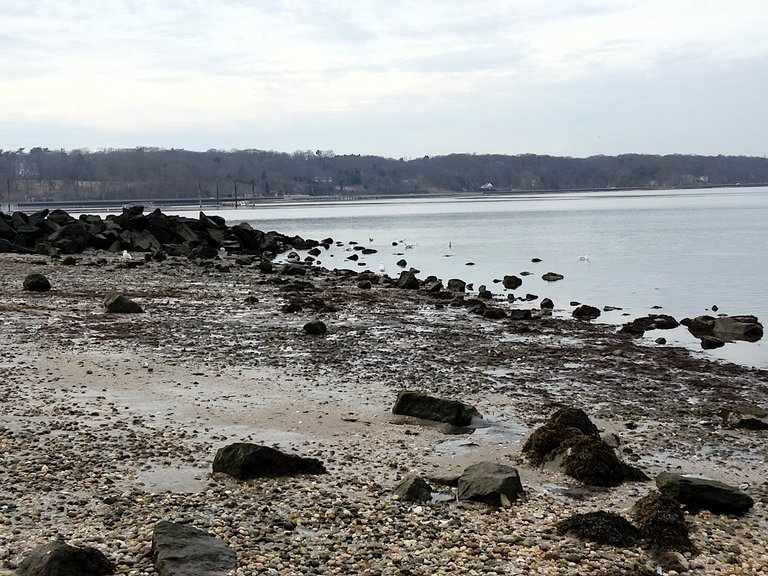
How does the survival strategy of the gull work out for them? According to one website, Movement Ecology, gulls that choose an urban habitat (along the Atlantic coast) rather than a marine habitat (Great Lakes and Arctic) suffer worse survival rates. Winter survival rates range from between 80% to 91%, with the lower number representing gulls "...in the Atlantic region...". I think with a mild winter and the marine resources available to my local gulls, they should do rather well. I hope to see most of them in the spring.
Birds, of course, aren't the only living beings trying to survive in winter. There are people, and dogs, wearing coats. Here's a picture of me taking a picture. The family dog is at my side. (My daughter captured this surreptitiously).
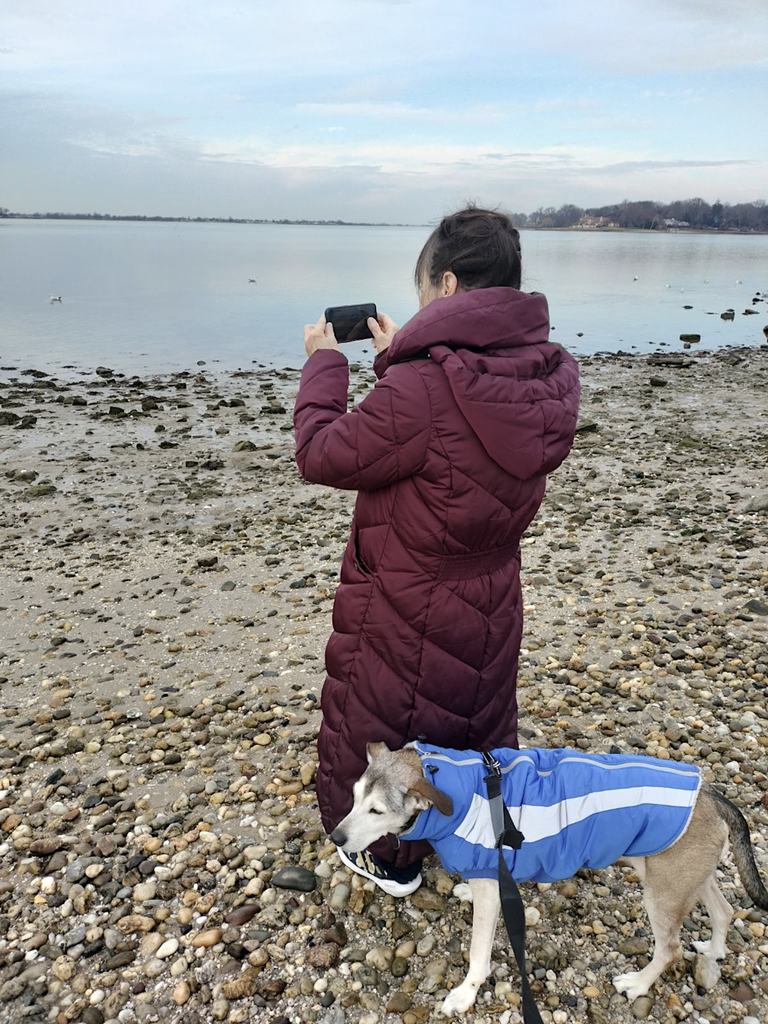
Not only humans and animals try to survive winter temperatures. Trees also have a survival strategy. They shed their foliage until more temperate weather arrives. Here is a picture of a beautiful, starkly bare tree. I caught this photo yesterday as I walked along the shore.
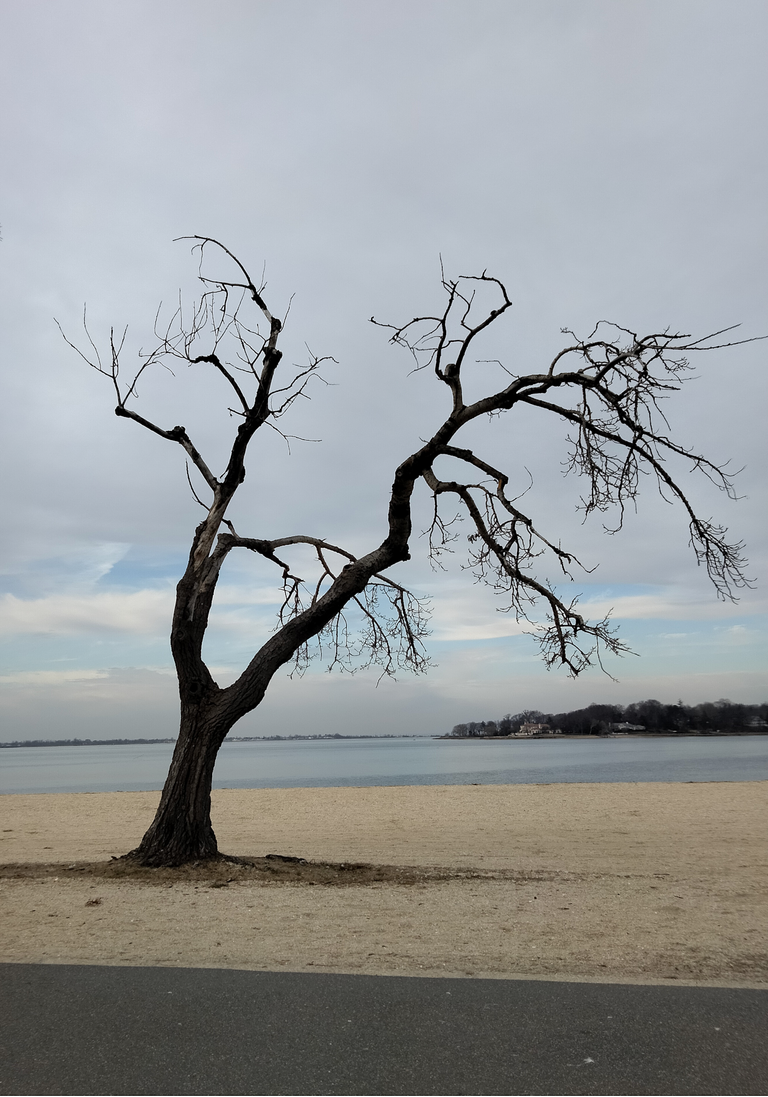
I hope you enjoyed sharing these photos of my excursion to the shore, and the gull habitat. In order to get the brief YouTube videos uploaded, I had to open a YouTube channel. Now that I know how to do that, I guess I'll be posting more videos on Hive.
All videos and pictures in the post are mine (except the one shot by my daughter, and she gives permission for me to use it)
Thank you for reading. Be peaceful. Be well.
Great set of images. The shot with the seagulls on the posts reminds me of Alfred Hitchcock's The Birds
They got the car😂
We have 2 dogs that we rescued from a local farmer who was planning to shoot them, Devil dog and Sparticus Sparticus. During an unusually cold period a couple of years ago we tried to put a coat on Devil Dog. She jumped at least 6 feet in the air spraying urine all over us and then ran into the chicken coop where she stayed until dinner time. I tell you, we never tried it again.
⭐️🐕⭐️
Well, Devil Dog surely lived up to her name😂
I think we got away with the coat(a new addition) because the dog is so old. First time out she seemed uncomfortable, but now she has adjusted.
We appreciate your work and your publication has been hand selected by the geography curation team on behalf of the Amazing Nature Community. Keep up the good work!
Thank you very much. I appreciate that. This is a lovely community. Nature--feel right at home with this subject.
Yes i do enjoy these photos, especially the one your dog is in. I loved to see him wearing something to keep him safe from col.d
Thank you! The dog is old and needs the coat :) She is wonderful though. Thank you for reading, @itwithsm
Thank you very, very much!
Shore Looks a calm and peacful place.Gulls and birds are searching their foods .
Thank you for stopping by and reading, @jahanzaibanjum
The natural beauty is extraordinary.
Thank you!
I love all the pictures
Also, winter looks very good over there
Nice one!
The birds are really enjoying the cool nature
Everyone likes to be close to nature. It was indeed a beautiful area
Protection from cold is necessary for everything, both for humans and animals. It's good to see that you all take such great care of your animals.
Hello @agmoore . Very interesting and detailed your post about the feeding habits of the gulls in your locality and they are a product of your observation.
Gulls survive by their diverse foraging, even in the waste left by humans. I have seen this behavior in black and white herons that are constantly in the garbage dump of the residences where I live and a few years ago this did not happen. It seems to be a survival strategy due to the loss of natural places.
Thank you very much for sharing this information.
Happy day!